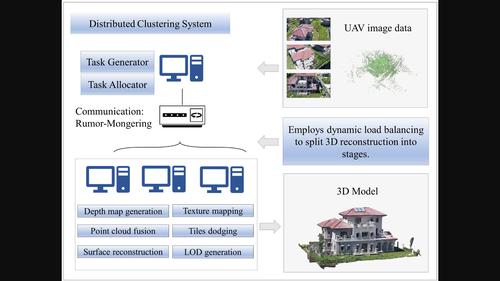Rapid 3D modelling: Clustering method based on dynamic load balancing strategy
引用次数: 0
Abstract
Three-dimensional (3D) reconstruction is a pivotal research area within computer vision and photogrammetry, offering a valuable foundation of data for the development of smart cities. However, existing methods for constructing 3D models from unmanned aerial vehicle (UAV) images often suffer from slow processing speeds and low central processing unit (CPU)/graphics processing unit (GPU) utilization rates. Furthermore, the utilization of cluster-based distributed computing for 3D modelling frequently results in inefficient resource allocation across nodes. To address these challenges, this paper presents a novel approach to 3D modelling in clusters, incorporating a dynamic load-balancing strategy. The method divides the 3D reconstruction process into multiple stages to lay the groundwork for distributing tasks across multiple nodes efficiently. Instead of traditional traversal-based communication, this approach employs gossip communication techniques to reduce the network overhead. To boost the modelling efficiency, a dynamic load-balancing strategy is introduced that prevents nodes from becoming overloaded, thus optimizing resource usage during the modelling process and alleviating resource waste issues in multidevice clusters. The experimental results indicate that in small-scale data environments, this approach improves CPU/GPU utilization by 35.8%/23.4% compared with single-machine utilization. In large-scale data environments for cluster-based 3D modelling tests, this method enhances the average efficiency by 61.4% compared with traditional 3D modelling software while maintaining a comparable model accuracy. In computer vision and photogrammetry, research enhances 3D reconstruction for smart cities. To address slow UAV-based methods, the study employs dynamic load balancing and ‘gossip’ communication to minimize network overhead. In small data tests, the approach improves CPU and GPU efficiency by 20.7% and 40.3%, respectively. In large data settings, it outperforms existing methods by 61.38% while maintaining accuracy.

快速 3D 建模:基于动态负载平衡策略的聚类方法
三维重建是计算机视觉和摄影测量中的一个关键研究领域,为智慧城市的发展提供了宝贵的数据基础。然而,现有的利用无人机(UAV)图像构建三维模型的方法往往存在处理速度慢、中央处理器(CPU)/图形处理器(GPU)利用率低等问题。此外,利用基于集群的分布式计算进行三维建模经常导致节点间资源分配效率低下。为了解决这些挑战,本文提出了一种新颖的集群三维建模方法,结合了动态负载平衡策略。该方法将三维重建过程划分为多个阶段,为在多个节点间高效分配任务奠定了基础。与传统的基于遍历的通信不同,这种方法使用八卦通信技术来减少网络开销。为了提高建模效率,引入了一种动态负载平衡策略,防止节点过载,从而优化建模过程中的资源使用,减轻多设备集群中的资源浪费问题。实验结果表明,在小规模数据环境下,与单机利用率相比,该方法的CPU/GPU利用率分别提高了35.8%/23.4%。在大规模数据环境下进行基于聚类的三维建模测试时,该方法在保持模型精度的同时,平均效率比传统三维建模软件提高了61.4%。在计算机视觉和摄影测量方面,研究增强了智慧城市的三维重建。为了解决基于无人机的慢速方法,该研究采用动态负载平衡和“八卦”通信来最小化网络开销。在小数据测试中,该方法将CPU和GPU的效率分别提高了20.7%和40.3%。在大数据环境下,在保持准确性的情况下,该方法比现有方法高出61.38%。
本文章由计算机程序翻译,如有差异,请以英文原文为准。
求助全文
约1分钟内获得全文
求助全文

 求助内容:
求助内容: 应助结果提醒方式:
应助结果提醒方式:


